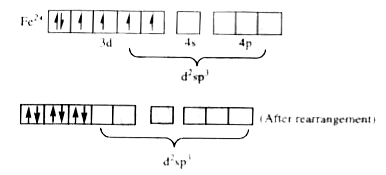The d-orbitals participating in hybridisation of metal atom may be from the n & (n-1) shell. This depends on the nature of metal and nature of ligand. The complexes involving the inner d-level (inner orbital complexes) results when the ligand is a powerful (or) strong ligand results in a diamagnetic (or) low spin complexes. A weak ligand usually results in the formation of outer orbital complex (or) high spin complex.
Number of unpaired electrons present in [Fe(CN)6]4−&[Fe(H2O)6]2+ are respectively. Solution in Telugu
4,4
0,0
0,4
2,4
The correct Answer is:C
CN− : Strong field ligand and electronic rearrangment is possible H2O weak field ligand and no electric rearrangement.

(in presence of H2O) )

(in presence of CN− )
Topper's Solved these Questions
- BOOK - AAKASH SERIESCHAPTER - CO-ORDINATION COMPOUNDSEXERCISE - LEVEL-II EXERCISE-III (Match the following questions)13videos
CO-ORDINATION COMPOUNDS
- BOOK - AAKASH SERIESCHAPTER - CO-ORDINATION COMPOUNDSEXERCISE - LEVEL-II EXERCISE-IV (Integer answer type Questions)8videos
CO-ORDINATION COMPOUNDS
- BOOK - AAKASH SERIESCHAPTER - CO-ORDINATION COMPOUNDSEXERCISE - LEVEL-II LECTURE SHEET EXERCISE-II (Linked Comprehension type questions ) Passage-V3videos
CO-ORDINATION COMPOUNDS
- BOOK - AAKASH SERIESCHAPTER - CHEMISTRY IN EVERYDAY LIFE EXERCISE - PRACTICE SHEET - 2 (PRACTICE SHEET -2 (INTEGER ANSWER TYPE QUESTIONS))7videos
CHEMISTRY IN EVERYDAY LIFE
- BOOK - AAKASH SERIESCHAPTER - COMPLEX COMPOUNDS EXERCISE - PRACTICE EXERCISE45videos
COMPLEX COMPOUNDS
Similar Questions
Match Column-I (Compounds) with Column - II (Oxidation states of Co) and select the correct answer using the codes given below the Columns
 05:22View Solution
05:22View SolutionHow many EDTA molecules are required to make an octahedral complex with a Co2+ ion ?
05:16View SolutionThe stability of complex ion depend upon charge, size electronegativity of metal ion. Greater the charge of metal ion greater would be the stability. As size of metal ion decreases stability of metal ion increases complex ion more stable if chelating ligand present.
Fe+3+6CN−⇔[Fe(CN)6]−3,K1
Fe+2+6CN−⇔[Fe(CN)6]−4,K2 : the value of K1 and K2 are02:19View SolutionOne mole Benzene in presence of light on reaction with 'x' moles of Cl2 forms B.H.C. what is 'x' ?
06:58View SolutionThe primary and secondary valencies of the central metal ion in the complex [Co(NH3)6]Cl3 respectively are
View SolutionWhich of the folliwing complex is inner orbital as well as low spin complex? .
04:19View SolutionOn the basis of crystal field theory explain why Co(III) Forms paramagnetic octahedral complex with weak field ligands whereas it forms diamagnetic octahedral complex with strong field ligands.
07:37View SolutionIn the formation of octahedral complex , ligands approach towards ________ and ______ orbital of central metal
03:17View SolutionAssertion : Inner orbital complexes are low spin complexes . Reason : In low spin complexes , inner d-orbital (3d) is used in hybridisation .
05:16View SolutionWhich of the complex is inner orbital as well as diamagnetic in nature ?
07:17View SolutionIn the formation of octahedral complex, ligands approach towards_____ and________ orbital of santal metal
02:54View SolutionWhich of the following complex compound is low spin, inner orbital , diamagnetic complex ?
02:54View SolutionThe d-orbitals participating in hybridisation of metal atom may be from the n & (n-1) shell. This depends on the nature of metal and nature of ligand. The complexes involving the inner d-level (inner orbital complexes) results when the ligand is a powerful (or) strong ligand results in a diamagnetic (or) low spin complexes. A weak ligand usually results in the formation of outer orbital complex (or) high spin complex.
The hybridisation of Cu in [CuCl4]2−&[Cu(NH3)4]2+ are respectivlyView SolutionThe d-orbitals participating in hybridisation of metal atom may be from the n & (n-1) shell. This depends on the nature of metal and nature of ligand. The complexes involving the inner d-level (inner orbital complexes) results when the ligand is a powerful (or) strong ligand results in a diamagnetic (or) low spin complexes. A weak ligand usually results in the formation of outer orbital complex (or) high spin complex.
Among the following sets, the one having the same geometry and same magnetic property for both complexes is40:03View SolutionAssertion : Inner orbital complexes are low spin complexes .
Reason : In low spin complexes , inner d-orbital (3d) is used in hybridisation .05:02View Solution

